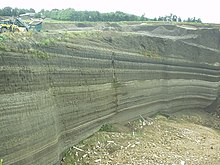Volcanic Eifel
Volcanic craters, thick pumice and basalt layers and maars create a diverse landscape that clearly witnesses to very recent events in geological terms.The entire Volcanic Eifel covers an area of about 2,000 km2 (770 sq mi) and as of 2007[update] has a population of about 200,000.The following volcanoes belong to the Eifel, sorted by height in metres (m) above sea level (Normalhöhennull, NHN)[1]: Of particular note is the volcanic caldera known as Laacher See, the site of an eruption around 12,900 years ago that had an estimated VEI of 6.These have in turn been utilised to ascertain the ages of climatic changes such as transitions from glacial to interglacial states during the Pleistocene.[2] There is thought that future eruptions may occur in the Eifel, because:[3][4] In 2020, Professor Kreemer noted that Eifel was the only region within an area of Europe studied where ground motion happened at significantly higher levels than expected.



VulkaneifelLaacher Seevolcanic crater lakeAndernachWeinfelder MaarTephraMofettasGermanvolcanic activityvolcanic fieldsvolcaniccrater lakesvolcanic cratersWittlich DepressionSouth EifelArdennesNorth EifelHohes VennManderscheidGerolsteinObere KyllHillesheimAdenauKelbergBrohltalVordereifelMendigPellenzMayen-Koblenz districtpumicebasaltList of mountains and hills of the EifelNormalhöhennullErnstbergSchartebergEifel TransmitterPrümscheidDietzenleyHochkelbergNerother KopfHochsimmerGänsehalsKempenichHochsteinSteinebergerRockeskyller KopfHoher ListHoher List ObservatoryStrohnVeitskopfEttringenKarmelenbergVolcano Museum, Dauntephrasargon-argon datingK-feldsparglacialinterglacialPleistoceneground motionmagma plumeNatureGlobal Volcanism ProgramSmithsonian InstitutionCentral UplandsAnterior Bavarian ForestEinödriegelBlack ForestFeldbergBohemian ForestGroßer ArberBavarian ForestDeisterBröhnEbbe MountainsNordhelleEgge Mountains(Prussian) VelmerstotHohe AchtElbe Sandstone MountainsGroßer ZschirnsteinEilumer HornElster MountainsKapellenbergFichtel MountainsSchneebergSteinwaldPlatteFranconian ForestDöbrabergFranconian JuraDürrenbergGladenbach UplandsAngelburgGoshawk ForestHohes GrasBrocken (Blocksberg)Hildesheim ForestGriesbergBloße ZelleHoher MeißnerKasseler KuppeHunsrückErbeskopfSoonwaldEllerspringKaiserstuhlTotenkopfKaufungen ForestHirschbergKellerwaldWüstegartenKnüllEisenbergKyffhäuserKulpenbergLenne MountainsHomertLippe UplandsKöterbergNorth Palatine UplandsDonnersbergOdenwaldKatzenbuckelOre MountainsFichtelberg
